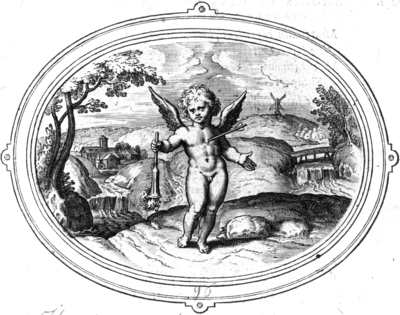Quod nutrit, extinguit [96]

Translations
 |
[Heinsius, Emblemata amatoria 5.1/5.3]. Wat me voedt, dooft me ook. |
 |
[Heinsius, Emblemata amatoria 5.1/5.3]. What feeds me, extinguishes me. |
 |
Zoals een fakkel door het vet waarmee hij wordt gevoed, ook weer dooft, zo kom ik om door wie ik leef en sterf door degene
op wie ik smoorverliefd ben. |
 |
As a torch is extinguished by the fat that feeds it, thus who gives me life, feeds me and infatuates me engenders my death. |
Literature
- Henkel and Schöne, Emblemata
 , col. 1365
, col. 1365
- Praz, Seventeenth-Century Imagery
 , p. 113
, p. 113
- Sebastiàn, Lectura crítica
 , p. 43
, p. 43
Sources and parallels
- Latin quote, Latin and French mottoes, pictura: Qui me nourrist, m’estaind [5] (in: Daniël Heinsius, Emblemata amatoria (1607/8))
[Compare
![Compare [compare]](/static/images/compare2.gif) ]
]
- Jezus holding a torch in: De verlichte Ziele spreeckt, hoe, of op welck een wijse dat Godt de sonden vergeeft [15] (in: Jan Luyken, Jesus en de ziel (1685))
[Compare
![Compare [compare]](/static/images/compare2.gif) ]
]
- Torch, head down: Amor, tela penelopes. [44] (in: Jacob Cats, Sinne- en minnebeelden (1627))
[Compare
![Compare [compare]](/static/images/compare2.gif) ]
]
- Parallel in an affixio: Porteman, Emblematic exhibitions
 , pp. 174-175
, pp. 174-175 -
A Parallel for the motto and the main pictorial element (mirrored): Qui me nourrist, m'estaind. [29] (in: Daniël Heinsius, Ambacht van Cupido, from: Nederduytsche poemata (1616))
[Compare
![Compare [compare]](/static/images/compare2.gif) ]
]
-
A Parallel (and probably source) for the emblem (motto, Latin subscriptio and pictura): Qui me nourrist, m’estaind [5] (in: Daniël Heinsius, Quaeris quid sit Amor (c. 1601))
[Compare
![Compare [compare]](/static/images/compare2.gif) ]
]
-
Parallel for the pictura (mirrored) and the Latin and French motto in: Un Amour tenant un Flambeau la flamme en bas, & percé d’une Fléche (in: Daniel de la Feuille, Devises et emblemes (1691))
[Compare
![Compare [compare]](/static/images/compare2.gif) ]
]
References, across this site, to this page:
- Amor, tela penelopes. [44] (in: Jacob Cats, Sinne- en minnebeelden (1627))
- Un Amour tenant un Flambeau la flamme en bas, & percé d’une Fléche (in: Daniel de la Feuille, Devises et emblemes (1691))
- Qui me nourrist, m’estaind [5] (in: Daniël Heinsius, Quaeris quid sit Amor (c. 1601))
- Qui me nourrist, m’estaind [5] (in: Daniël Heinsius, Emblemata amatoria (1607/8))
- Qui me nourrist, m'estaind. [29] (in: Daniël Heinsius, Ambacht van Cupido (1613))
- Qui me nourrist, m'estaind. [29] (in: Daniël Heinsius, Ambacht van Cupido, from: Nederduytsche poemata (1616))
- De verlichte Ziele spreeckt, hoe, of op welck een wijse dat Godt de sonden vergeeft [15] (in: Jan Luyken, Jesus en de ziel (1685))
Iconclass
A cupid hit by an arrow is holding a torch upside down- fire (one of the four elements)
[21C]

- trees
[25G3]

- river
[25H213]

- farm or solitary house in landscape
[25I3]

- windmill in landscape
[25I41]

- violent death by arrow(s) - EE - death not certain; wounded person
[31EE23461]

- lovesick lover
[33C971]

- torch - BB - torch held upside down (+ kindling a light; lit, burning light, lamp, candle)
[41BB32(+1)]

- archer's weapons: arrow
[45C15(ARROW)]

- proverbs, sayings, etc. (with TEXT)
[86(QUOD NUTRIT EXTINGUITUR)]

- (personifications and symbolic representations of) Love; 'Amore (secondo Seneca)' (Ripa) (+ emblematical representation of
concept)
[56F2(+4)]

- Vitality, Viability, Vital Force (+ emblematical representation of concept)
[58B1(+4)]

- Mortality, Extinction of Life (+ emblematical representation of concept)
[58BB1(+4)]

- suffering, misfortune of Cupid
[92D16]

- attributes of Cupid (with NAME)
[92D18(ARROW)]

- attributes of Cupid (with NAME)
[92D18(TORCH)]

![[H O M E : Emblem Project Utrecht]](/static/images/rd-small.gif)


















































































































































